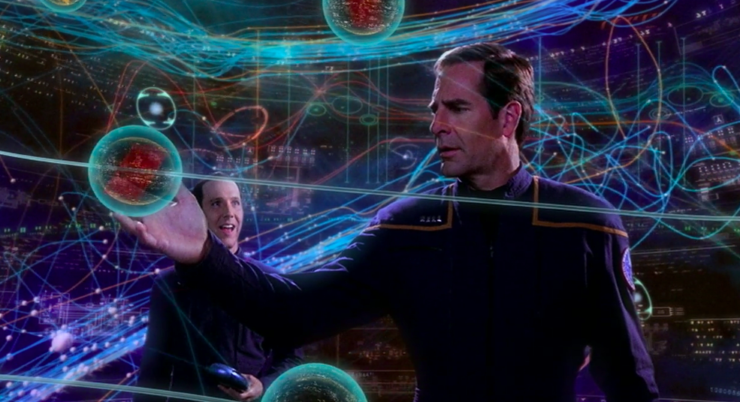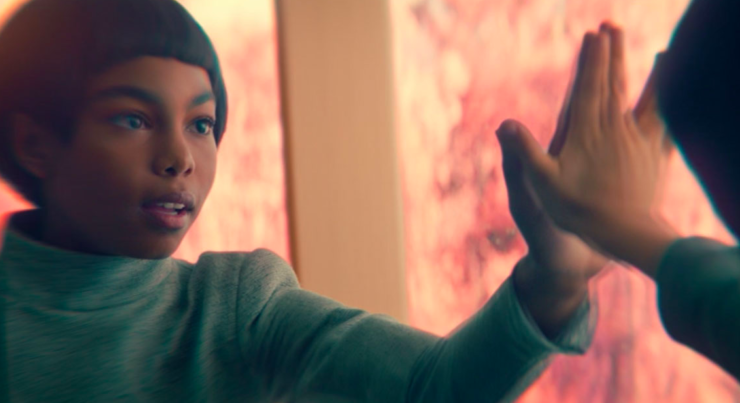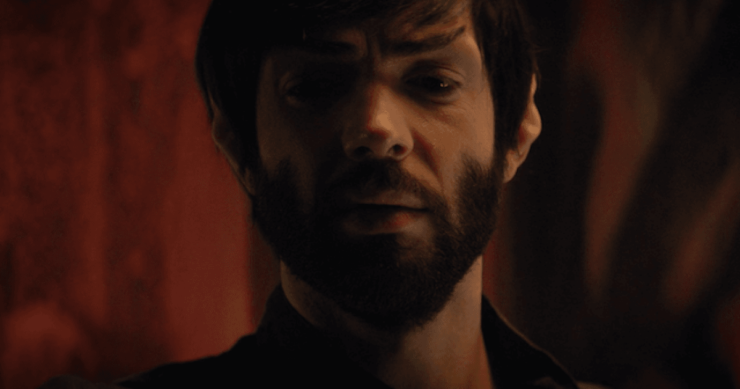When a prequel series to the original Star Trek was announced, hardcore fans started freaking out and these are the kinds of things they said: How can anything that takes place before the OG Trek effectively reconcile the discrepancy between retro-future tech of the 1960s and the slick tech of the 21st century? Plus, why are they wearing all-blue jumpsuits! Funnily enough, these complaints aren’t unique to the discussion about Star Trek: Discovery; the same exact conversations were happening when the prequel series Enterprise aired in 2001.
From its very first episode, Enterprise casually floated the idea that someone from the future might be messing with the past, and also, the canon. And now it looks like some that stuff may actually happen. Is Discovery heating up the temporal cold war? Will season 2 change the Prime Timeline? Right now, all signs point to yes.
Spoilers ahead for Star Trek: Discovery season 2, specifically episode 7, “Light and Shadows.”
Starting with the episode “Saints of Imperfection,” the latest season of Discovery stated to get serious about the possibility of time travel. The presence of “tachyons” in “Brother” suggests that Section 31 believed some kind of time travel interference was going down. Then, in “The Sound of Thunder,” after Saru could see that the elusive Red Angel was wearing a suit made of future technology, everyone quickly got onboard with the idea that someone from the future is running interference on the past. Most recently, in “Light and Shadows,” Captain Pike and Tyler narrowly-escaped a Time Rift that eventually turned into a Time Tsunami. The immediate result of this was a souped-up robot-probe, which originated on Discovery, but as Tyler explained: “It’s our probe, but somehow it got an upgrade,” and that the probe’s core had aged “500 years.”

If Tyler was speaking literally, and the probe somehow went 500 years into the future, exactly, that would make it from the year 2757, sometime in the 28th century. In Star Trek Enterprise, there was an overarching storyline dubbed the “Temporal Cold War” where various factions from various centuries fought each other over a roughly thousand-year time span. One of these factions (and the one most visible in Enterprise) was led by a mysterious figure stationed in the 28th century. The show was cancelled before we got to see who the “mysterious benefactor” was, and arguably before we got to see the full scope of this giant… time war.
The Temporal Cold War stuff in Enterprise doesn’t even have to be directly referenced in Discovery to work with canon, because the inherent nature of a time travel war is that stuff could be changing in the timeline without anyone really even knowing. Or to put it another way, Discovery could casually imply the series is taking place in an altered timeline just by explaining the motivations of the Red Angel. If the Red Angel is a time traveler, and it did save Burnham when she was a little kid, could that have created an alternate timeline? Since the first episode of Discovery, fans have been pretty freaked out that Burnham was Spock’s sister in childhood and he never mentioned her in existing canon.
But this presupposes that Burnham exists in the prime timeline to begin with. What if this season asserts that Burnham was “supposed” to die in childhood in the Prime Timeline, but that the Red Angel changed everything? And, what if that is just one faction of a new — or ongoing, Temporal Cold War?
In “Light and Shadows,” Georgiou also revealed that Leland was somehow responsible for the death of Burnham’s parents, which is also weird. What if in killing Burnham’s parents, Leland also was trying to kill Burnham? If Leland’s version of Section 31 is already time traveling, then they might know that Burnham being alive — in any timeline — changes the universe in huge ways. The latest episode heavily implies that Georgiou knows way more about Michael Burnham than she’s willing to admit. This could mean, that through her involvement in Section 31, Georgiou has seen various timelines where Burnham has died at different points in her life. It’s also possible that via time travel Georgiou has been the one saving her, perhaps even preventing the Klingons (hired by Leland in this theory) from killing young Burnham along with her parents. This may suggest Georgiou is the Red Angel, but then again, maybe not.

The last piece of the puzzle seems to be Talos IV, introduced late in the game in “Light and Shadows.” Assuming that Discovery doesn’t take place in a modified timeline, then chronologically speaking, this will be the second of three times Spock has visited Talos IV in his life. But the idea that Spock goes to Talos IV in between “The Cage” and “The Menagerie” seems borderline crazy, and nearly impossible to reconcile with canon. Last season, Discovery made the Mirror Universe “classified” to prevent any canon inconsistencies with “Mirror, Mirror” in the original series—will they pull that same trick again with Talos IV?
Leading up to the premiere of season 2, showrunner Alex Kurtzman said that this season would reconcile all the continuity issues of the first season. In 2018, Kurtzman said: “By the end of the season, we will be synced up with canon.” But, synced up with canon doesn’t necessarily mean that canon will remain unmodified. And the existence of time travel from the future combined with Spock’s extra trip to Talos IV, almost certainly means that by the end of this season of Discovery, something about the timeline will have been changed forever.
Season two of Star Trek: Discovery has seven episodes left. It airs on Thursday nights at 8:30 pm eastern time on CBS All-Access.
Ryan Britt is the author of Luke Skywalker Can’t Read and an editor at Fatherly. He is a longtime contributor to Tor.com.











I think I can get behind this theory, especially if you take into account the theory that Enterprise is already in an alternate timeline stemming from the events of First Contact.
Spock is the time traveler. Because in Star Trek everything begins and ends with Spock.
Time travel. Yay.
What if this shows why Talos IV is the only death penalty on Federation Books. The Cage never was a strong excuse in my opinion.
No, fans have not “been pretty freaked out that Burnham was Spock’s sister in childhood and he never mentioned her in existing canon”. Some fans have, while most others just went along with it, just as we did when it turned out that Spock’s father was the Vulcan ambassador, or when it turned out he had a fiancee, or when it turned out he had a brother. None of which he’d never mentioned before.
I thought making Michael Spock’s sister was a bad idea because, hey, there are other Vulcans! But I was never bothered by the fact Spock had never mentioned her. Spock doesn’t talk about his family. His best friends had no idea who his parents were, that he had a fiancee or that he had a brother until they became plot points. So why would they know about his sister, the infamous Michael Burnham?
Oddly Spock does talk about his family to his fatherly mentor Captain Pike. Now that could do with some explaining!
#5
Yeah, I don’t mind Spock having a sister we never heard of before, but there is some ‘been there, done that’ with the idea. Discovering weird outer space mysteries on the frontier — yay! Discovering the mysteries of Spock’s family tree… meh.
Also, it just seems like a cheap and easy way of linking to the established iconography without doing the hard work of making an interesting lead character I can care about. It would be like if Picard had been a descendant of one of the TOS characters and was trying to live up to the legend, and that was his main character trait. No Shakespeare, no Dixon Hill, no archaeology, no discomfort with children, no being stabbed through the heart, etc.
The question for me isn’t ‘why does Spock have a sister?,’ it’s ‘why should I care about this person?’ Burnham is barely a character in her own right.
“The last piece of the puzzle seems to be Talos IV…”
Don’t forget “Calypso” and Discovery being stranded in the future. There’s also the creation of an AI in that short.
Also, add Airiam as another puzzle piece. She looks good as a candidate for the Red Angel. She’s already techno-organic. Maybe the armor Saru sees is her evolved self. Whether she’s an agent for another entity is another question.
I truly hope the writers pull all the pieces together and don’t just attempt fake outs for the sake of throwing out twists.
Well, there might be a hint in this image from ep. 3, “Point of Light” when Georgiou appears on Qo’noS. When she initially beams in, its more obvious, with the wall panels seen symmetrically behind her, like red “wings”. I noted it as a kind of ironic visual pun, but it may be foreshadowing something.
Quoth Ryan: “But the idea that Spock goes to Talos IV in between “The Cage” and “The Menagerie” seems borderline crazy, and nearly impossible to reconcile with canon.”
No, it doesn’t. Not even a little bit.
—Keith R.A. DeCandido
Some fans have, while most others just went along with it, just as we did when it turned out that Spock’s father was the Vulcan ambassador, or when it turned out he had a fiancee, or when it turned out he had a brother. None of which he’d never mentioned before
Kirk: “You don’t have a brother.”
Spock: “That is correct.”
Kirk: “Aha.”
Spock: “I have a half-brother”
Kirk: “FOR THE LOVE OF THIS INFORMATION MIGHT HAVE BEEN RELEVANT AT SOME POINT WHY DO I EVEN”
Kirk: Spock, you don’t have a sister.
Spock: That is correct. I have a human foster sister.
Kirk: Aaarrrrrgh!
I would bet on Michael Burnham becoming the Red Angel. As a character she is altruistic and unattached, and her disappearance would handily explain Spock’s apparent lack of a human sister.
And of course she’s connected to it, directly and via Spock.
Against that, it’s a TV series and the writers themselves don’t know how long it will last, and she is the central character. So maybe writing her out is beyond possibility.
That’s ultimately a flaw in the form, I guess.
It’s crossed my mind that far from being evidence that this is a different timeline, Spock and Pike encountering the Talosians again between “The Cage” and “The Menagerie” might actually be decent bridging material providing set-up for the latter storyline: It was a bit of a leap for Spock to be able to contact the Keeper, who he never met in “The Cage”, and for them to be convinced the Talosians would help Pike if there’d simply been one less-than-friendly prior encounter.
“The timeline has been changed by undefined time-travel shenanigans” is kinda neat, but it’s also a cheap way for the writers to jettison previous history — a clean slate (a) requires less research, and (b) unfetters personal creative preferences. Streamlining the script workflow (“the continuity czar says we can’t do X, Y can be reinterpreted as unreliable historical records, and Z is okay because it’s unsupported fanon but we should hang a lantern on it”) is probably more important to the show-runners than offending the portion of the fan-base who notice such changes; the more casual portion don’t care.
The same trope is explicitly used in the Terminator movies and TV series to explain the sliding scale of “Skynet is created at Date T and destroys the world at Date T+N”.
For Doctor Who the trope hasn’t been explicitly cited, but it has long been used by fans to explain apparent historical inconsistencies introduced by decades of show, even before the 2005 relaunch. The Dalek-Time Lord time war presumably had some kind of fallout, but the Doctor’s never detailed it to a companion. “Did you know, before the Time War, the U.K. conducted an interplanetary space program in the 1970s? Also, humanity evacuated Earth six times over the next 50 millennia.”